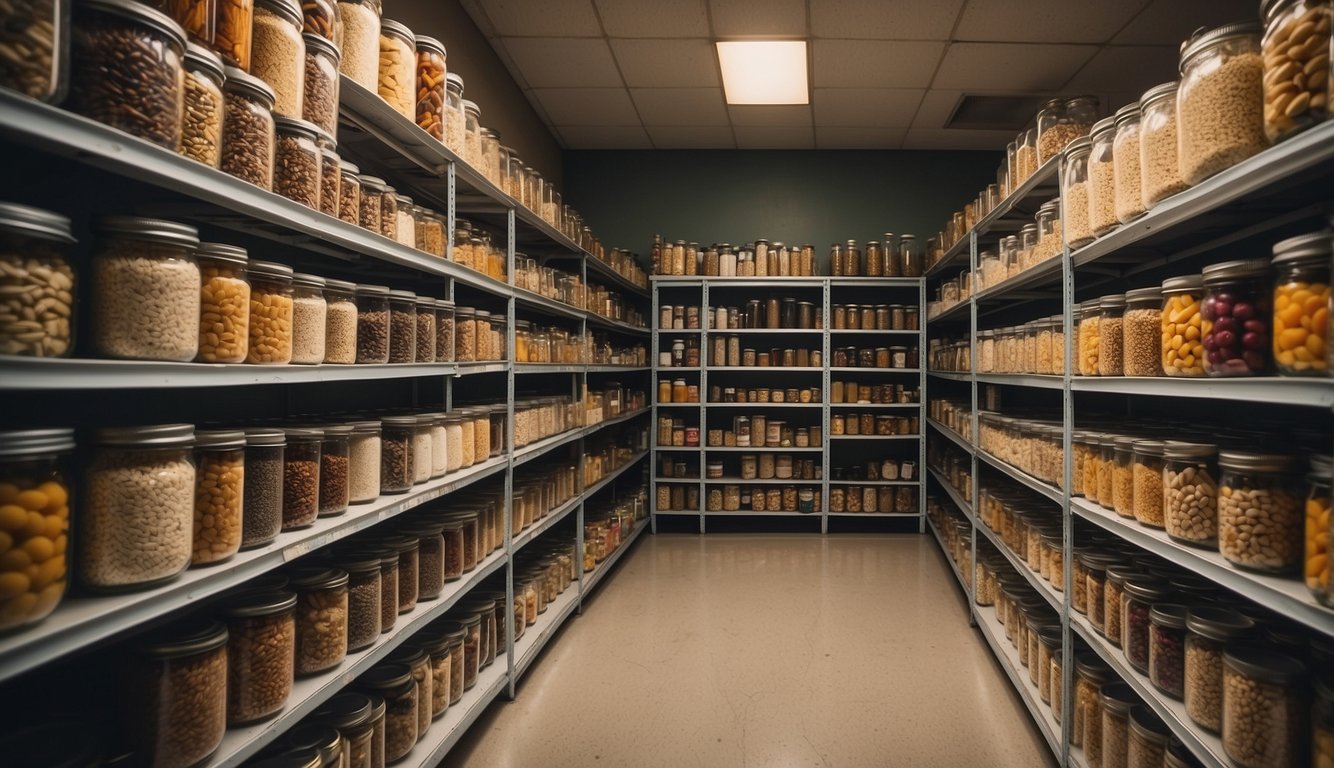Good Prepper Food for Long-Term Storage: Your Ultimate Pantry Guide
In preparing for unexpected situations, securing a reliable food supply is crucial. Whether facing natural disasters, economic downturns, or other emergency scenarios, your ability to access adequate nutrition can be a decisive factor in your resilience and survival. Good prepper food isn’t just about what you store but also about how you store it for the long term. Long-term food storage requires foods with extended shelf lives, minimal dependence on refrigeration, and the ability to provide sufficient calories and nutrition when fresh food might not be available.

Creating a prepper pantry involves more than just piling up non-perishable items. It’s about understanding the balance of nutritional needs, the longevity of different food types, and the best methods to preserve their quality over time. It means considering energy-dense foods, variety for health and morale, and also ease of preparation under potentially difficult circumstances. As you curate your long-term food stores, incorporating techniques like dehydrating, freeze-drying, and vacuum-sealing can vastly extend the shelf life of your provisions, ensuring your peace of mind.
Key Takeaways
- A reliable supply of nutritionally balanced, long-lasting food is key to prepping for emergencies.
- Prepper pantries should include a variety of food preservation methods to extend shelf life.
- Regularly maintaining your food stores ensures readiness and helps manage prepping budgets.
Table of Contents
Basics of Food Storage for Preppers
When preparing for long-term food storage, you need to balance shelf life, nutritional value, and practicality. Here’s how to start.
Understanding Long-Term Food Storage
Long-term food storage is your safety net during prolonged disaster scenarios, requiring foods that remain edible for years. Key factors affecting longevity include moisture, oxygen levels, and proper sealing. Products like oxygen absorbers and mylar bags can significantly extend the shelf life of your food stockpile. Familiarize yourself with the storage needs of each food type to preserve their freshness and safety.
Selecting the Right Food Types
For a robust pantry, focus on staples that offer versatility and long shelf life:
- Grains: Rice, wheat, and pasta are classic choices, providing essential carbohydrates.
- Legumes: Including a variety of beans and lentils offers both protein and dietary fiber.
- Canned goods: Vegetables, fruits, and meats can be safely stored and are ready to eat.
- Oils: A source of healthy fats; choose stable options like coconut or olive oil.
These foods can form the foundation of a prepper’s diet and can be creatively cooked into various dishes.
Essential Nutritional Considerations
A balanced diet is crucial, even in survival situations. Your storage should cover all bases of nutrition:
- Carbohydrates: Found in grains, rice, and pasta.
- Proteins: Source these from dried beans and canned meats.
- Healthy fats: Oils are essential; stock up on olive or coconut oil.
Don’t forget vitamins and nutrients—consider multivitamins and stored foods rich in micronutrients to maintain overall health.
Effective Food Preservation Techniques
Mastering effective food preservation techniques will enhance your self-sufficiency and ensure that your pantry is well-stocked for the long-term. These simple methods will significantly extend the shelf life of various foods, letting you enjoy the fruits of your labor well into the future.
Canning Basics and Tips
Canning is a reliable way to preserve a wide range of foods, including canned fruits and canned vegetables. The key to canning is creating an airtight seal that prevents bacteria growth. You’ll need a few basic supplies: jars, lids, and a canner or large pot. Begin by sterilizing your jars and lids. Simmer the food you want to preserve and fill the jars, allowing some headspace. Wipe the rims clean, place the lids on, and screw the bands down until fingertip-tight. Process the jars in boiling water or a pressure canner according to your recipe. Once cooled, check the seals, and store your bounty in a cool, dark place.
- Supplies Needed: Jars, lids, canner/pot
- Steps: Sterilize, fill, wipe, seal, process, cool, check, store
- Tip: Label your jars with the date to keep track of the shelf life.
Dehydrating Food for Longevity
Dehydrating food removes moisture, making it an ideal method to extend the lifespan of various foods like dried fruits and herbs. You can use a food dehydrator or an oven on a low setting. Slice foods thinly and evenly for consistent drying and spread them on the dehydrator’s trays or on a baking sheet if using an oven. The drying time will vary depending on the food and thickness. Store the dehydrated foods in airtight containers in a cool, dark place to maximize their shelf life.
- Tools: Dehydrator or oven
- Process: Slice, spread, dry, store
- Reminder: Check periodically, as drying times will vary.
Freeze-Drying at Home
Freeze-drying is a fantastic option for preserving freeze-dried meals and other freeze-dried foods with minimal nutrient loss. While home freeze-drying equipment can be an investment, it allows you to store perishable items for years. The freeze-dryer works by freezing the food and then creating a powerful vacuum to remove the ice crystals. After the process is completed, you should seal the food in moisture-proof packaging. Properly freeze-dried food can last for decades when stored in a cool, dark place.
- Equipment Needed: Home freeze-dryer
- Method: Freeze, vacuum, seal, store
- Advantage: Preserves nutrients and taste for long-term storage.
With these foundational preservation techniques, you’re on your way to building a well-rounded and long-lasting food supply.
Water Storage and Purification
In planning for long-term survival, ensuring you have adequate water supplies and reliable purification methods is crucial for any prepper. As a backbone of your survival strategy, here’s how you can effectively manage your water needs.

Water Storage Solutions
Proper water storage is fundamental for survival. You should aim to store at least one gallon of water per person per day, with a target of ensuring a supply for at least two weeks. If space and resources allow, storing more is advisable for additional security. Consider the following solutions:
- Commercial Water Storage Containers: These come in various sizes and are designed specifically for long-term water storage.
- Food-Grade Plastic Barrels: Affordable and widely available, these barrels can hold larger quantities of water.
- Water Bladders: Flexible storage options that can fit into various spaces, including under beds or in crawl spaces.
- Glass, Stainless Steel, or BPA-Free Plastic Bottles: For smaller quantities, these materials are preferred to avoid chemical leaching.
Purification Methods for Safe Drinking
Storing water is one part of the equation; making sure it’s safe to drink is another. Here are some purification methods you can rely on:
- Boiling: Boil water vigorously for at least one minute to kill most pathogens.
- Chemical Treatment: Using unscented household bleach (8 drops per gallon), Iodine, or Chlorine Dioxide tablets as directed to kill microorganisms.
- Water Filters: Use a commercially made filter designed for backcountry or emergency use, ensuring it is capable of removing viruses, bacteria, and protozoa.
- UV Light: Handheld UV purifiers can effectively neutralize many microorganisms in clear water.
Remember to rotate your stored water and treat it every six to twelve months to maintain its safety. Properly sealed and stored away from contaminants, your water can be a lifeline in times of need.
Stockpiling Essentials: What to Store

When preparing your pantry for long-term storage, focusing on food items with extended shelf lives, nutritional benefits, and variety is crucial. You want to ensure that you can maintain a balanced diet, even in times of scarcity.
Long-Lived Foods to Prioritize
- Rice: A staple that can last up to 30 years when properly stored.
- Honey, Sugar, Salt: These essentials don’t spoil, and they’re important for both taste and preserving other foods.
- Canned Goods: Look for fruits, vegetables, and even meats that can last several years.
Proteins: Meat and Plant Options
- Canned Meats: Options like tuna and chicken provide necessary protein and can be stored for several years.
- Beef Jerky: A durable, protein-rich option.
- Nuts and Nut Butters: Store peanut butter and assorted nuts for a heart-healthy protein source.
- Legumes: Items like beans and lentils are not only rich in protein but also have a long shelf-life.
Diversity in Grains and Legumes
- Grains: Stockpile a variety of grains such as oats, rye, and pasta for carbohydrates and fiber.
- Beans: Include different types of dried beans which can last up to 10 years if stored properly.
- Legumes: Lentils are another great legume that can diversify your nutrient intake and can last for several years.
Maintaining Your Prepper Pantry
Ensuring your prepper pantry remains a reliable resource involves meticulous organization, precautionary measures against pests and contamination, and routine inspections to keep supplies fresh and usable.

Organization Strategies
Organizing your food storage effectively means maintaining clarity and accessibility. Use clear, labeled containers for bulk items like grains and legumes. Place foods with nearer expiration dates at the front of shelves to encourage rotation and reduce waste. Implementing a first-in, first-out system ensures foods are consumed in order of their shelf life. Utilize inventory lists to keep track of what you have and what might need replenishing.
- Shelves: Label each shelf by food type or expiration date.
- Containers: Use airtight containers to protect against moisture and to keep foods fresh.
- Inventory List: Regularly update an inventory list noting quantities, purchase, and expiration dates.
Pest Control and Preventing Contamination
To maintain the health of your food storage, safeguard it from pests and contamination. Store food in pest-proof containers, such as glass jars or metal tins. Seal any cracks or openings where pests could enter your storage area. Keep the area dry and clean, because pests are attracted to moisture and spills. Inspect packages for signs of infestation before adding them to the pantry and incorporate bay leaves or diatomaceous earth as a natural deterrent.
- Containers: Opt for pest-resistant materials.
- Cleanliness: Regularly clean shelves and containers.
- Natural Deterrents: Consider using bay leaves in grain containers.
Regular Checks and Refreshing Supplies
With time, every item in your storage will approach its expiration date. By implementing regular checks—such as monthly or quarterly—you can ensure the rotation of your supplies before they spoil. Check for signs of spoilage or damage, and if an item is nearing its expiration, plan to use it soon or replace it. Keep an eye on the storage environment as well, since extreme temperature fluctuations and moisture can compromise food quality.
- Monthly Checks: Briefly inspect each item’s condition and expiration date.
- Storage Conditions: Monitor the environment, aiming for cool and dry conditions.
- Item Rotation: Use or rotate out items that are nearing the end of their shelf life.
Cooking and Usage Tactics

In the realm of prepping, your ability to cook and use stored food efficiently is crucial. These tactics ensure you maintain nutrition and variety, especially when traditional cooking methods may not be available.
Cooking Without Power
If you’re without power, your cooking options may understandably seem limited. However, with solar ovens, camp stoves, and fire pits, you can still prepare hot meals. Here’s a quick guide:
- Solar ovens: Utilize the sun’s energy to cook or heat food.
- Camp stoves: Run on various fuels such as propane or butane.
- Fire pits: Require wood or charcoal and are useful for a variety of cooking methods like grilling or boiling.
Always have a stockpile of appropriate fuel and understand the basic operation of these tools before an emergency strikes.
Creative and Nutritious Meal Planning
To keep your meals nutritious and interesting, planning is key. Rotate through your stockpile to use the oldest items first and incorporate a balance of macros: proteins, carbs, and fats.
- Canned soups: Provide comfort and can be stretched by adding rice or pasta.
- Spices and condiments: Use these to enhance the flavor of bland foods.
- Don’t forget about vitamins and minerals; include canned fruits and vegetables in your plans.
By keeping nutrition in focus, you can plan meals that keep you healthy and satisfied for the long haul.
Utilizing Food in Everyday Cooking
Regularly including your emergency food in your daily cooking has several benefits:
- Promotes rotation: Ensures your stockpile is fresh and reduces waste.
- Familiarizes palates: Prevents taste fatigue by acclimating you and your family to stored food items.
- Practical experimentation: Discover which recipes work best for you, tweaking them for flavor, health, and enjoyment.
Remember, the goal is to make your transition into using prepped food seamless in emergency situations. The practice also allows for a smooth integration of comfort food into your diet, which can be an essential morale booster in stressful times.
Budgeting and Cost-Effective Prepping

When building your long-term food storage, it’s essential to balance cost-effectiveness with nutritional value and shelf life. Here’s how you can stock up on prepper food without breaking the bank.
Buying in Bulk and Finding Deals
Purchasing food in bulk is one of the most straightforward strategies to save money. Identify staple foods such as rice, beans, and lentils, which are not only cheap but also offer substantial nutritional value and have a long shelf life. Take advantage of sales at your local grocery store and consider joining a wholesale club to access lower prices. Store brands often offer the same quality as name brands at a reduced cost.
DIY Food Preservation
Incorporating DIY food preservation techniques like canning and dehydrating allows you to extend the shelf life of fresh produce and meats. Start with simple recipes and common methods such as water bath canning for acidic foods and using a dehydrator or oven for fruits, vegetables, and herbs. This not only grows your long-term storage options but also promotes a healthier diet, as you control the ingredients and avoid preservatives.
Long-Term Investment in Quality
Investing in quality ingredients for your prepper food stash can save money in the long run. Whole grains, for example, can be ground into flour for baking, which is a cost-effective alternative to purchasing prepackaged baked goods. When buying items like powdered milk, freeze-dried vegetables or meat, consider the calorie density and nutritional content. These items may seem pricier upfront but are a wise long-term investment in your health and self-sufficiency.
Frequently Asked Questions

In this section, you’ll find concise, practical answers to common questions on building a prepper food supply for long-term emergency preparedness.
What are the most cost-effective foods to store for long-term emergency preparedness?
Rice, beans, and lentils are amongst the most cost-effective foods to include in your long-term storage. They are inexpensive, nutritious, and have long shelf lives.
How can I determine the best types of food to stockpile for emergencies?
Prioritize foods that are non-perishable, require minimal water and cooking resources, and meet your nutritional needs. Diverse staples such as rice, pasta, canned vegetables, and dried meats should be considered.
Could you suggest the optimal containers for sustaining the shelf life of stored foods?
Food-grade buckets with airtight lids and Mylar bags are excellent for preserving food. They protect against pests and environmental factors and help maintain the freshness of your stored food.
What should I include in a comprehensive one-year emergency food storage plan?
Your plan should include a balance of proteins, carbohydrates, fats, vitamins, and minerals. Incorporate variety, such as grains, legumes, powdered milk, canned fruits and vegetables, and a selection of spices and condiments.
How do I use Mylar bags properly for long-term food preservation?
To use Mylar bags effectively, seal them with an appropriate amount of oxygen absorbers inside, ensuring all air has been expelled before heat sealing them shut. This method prevents oxidation and extends the shelf life of the contents.
What DIY methods can I employ for reliable long-term food storage at home?
You can dehydrate fresh produce, vacuum-seal bulk foods, and create your own meal preps with dried ingredients. Always store in a cool, dark, and dry place to maximize the shelf life of your DIY food stores.






